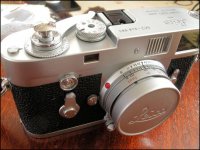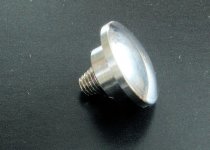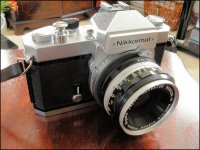R
ruben
Guest
A few days ago I got a couple a softies from Cameraquest, 2 normal size and 2 mini.
To tell the truth, the minies came quite by the good will of the sender. It never came across my mind what possible edge could a mini bring to me over the ultra comfortable normal one.
But upon trying the mini on a Kiev 6c (Medium Format) the technical edge became evident.
No doubt the mini is less comfortable than the normal, although more comfortable than the bare shutter button. But the mini brings an extra edge, or two edges flowing from the same characteristic.
The mini requires a more precision directional pressure to fire the shutter. In plain words this means that it is less prong to fire the shutter button by accident for the simple and mundane reason that its hat is smaller.
And in some situations you may have a camera that due to some mis-function requires a certain specific direction to push the shutter button. Some Canon ql among mine has this problem, for example.
The mini will also be a great solution for the Rolleiflex cameras, which offer a very small room for adding a softie.
As for the blessing of the mini on the Kiev 60 MF cameras, I have written a long discourse, which the interested ones may read in other forum, called The Kiev Report, and since the linkage is somewhat problematic, I will repeat here below:
Hi folks,
We should differentiate among three elements related to the accidental misfirings and best gripping of the cameras.
a) The Kiev 60/6c shutter button, which is badly designed (I will explain below)
b) The left side location of the shutter button on the Kiev 6c, which worsens the consequences of the badly designed shutter button.
c) The general ergonomics of the Kiev 60/6c, both in 6x6 and 645 formats, and the possibility of a side grip.
Furthermore, when we speak about ergonomics, we should also address another dimension of the problem. Medium Format is in between the large and small formats. Some of us may have an approach to the Kievs that tends towards a Large Format camera, others may tend towards the small format approach, and others may like to enjoy both.
This is of importance. If you go out to the mountains with your car, tripods, big case with your gear (don't forget your thermus!), I guess you are less prong to misfire your camera, unless you are late and pack all in a rush.
But if you go out for walking with your Kiev, and perhaps with two Kievs pending from your shoulders, making pictures on the go and exchanging lenses as well, then I would say your chances to accidentally fire the shutter are bigger. No need to say that in MF each frame counts.
Now I have some observations about the Kiev shutter button.
Along my photographic life I have held several cameras, whose shutter buttons can be divided into two groups:
Type A) long protruding shutter buttons requiring a long deppression finger travel, like in most of the rangefinders of the 60s and 70s (Konica Auto S. Canon Ql, etc) or MF cameras like the Iskra, Mamiya TLR, Rolleiflex etc. Here the accidental firing is prevented obviously by the long required depression.
Type B) very short protruding buttons, like in the OM SLRs, Contax/Kiev rangefinders, and Leica R rangefinder, where the accidental firing is prevented by a shield around the shutter button. In this case, in order to fire, the finger movement must be very precisely oriented - this is the most clever type.
Now let's ask ourselves, to which type the Kiev shutter button belongs ? To none of them. The Kiev 6c/60 shutter is an hybrid of the worst features of both types: it is short depressive, no shield around, long protruding and large !
Wonderfull ! Because wherever Kiev problems are, there are new challenges to face and opportunities for our creativity to reveal itself, puting us on a superior level than the average.
Upon the aknowledgement of the precise technical shortcoming, the solution may come. We have either to shield that short depression (to convert it into type b), or to extend the depression travel of the button (type a). This last solution sounds interesting, but requires some technical knowledge I don't have by now.
Nevertheless there is an element of type b buttons that I can start trying here and now: making the depression action more accurate so that no accidental "fat fingering" will action the button. How could we achieve a more precise directional depression movement of the button ? By installing a mini soft release of the type being sold by Cameraquest or Tom Abrahamson (google if you are interested).
I got a mini soft release today, and it happens that its convex face is slightly smaller than that of the Kiev shutter button. Then, theoretically, in order to depress the button you have less flat surface to push, and therefore, theoretically, each firing must be more accurate, i, e, purposedly intended.
Cheers,
Ruben
To tell the truth, the minies came quite by the good will of the sender. It never came across my mind what possible edge could a mini bring to me over the ultra comfortable normal one.
But upon trying the mini on a Kiev 6c (Medium Format) the technical edge became evident.
No doubt the mini is less comfortable than the normal, although more comfortable than the bare shutter button. But the mini brings an extra edge, or two edges flowing from the same characteristic.
The mini requires a more precision directional pressure to fire the shutter. In plain words this means that it is less prong to fire the shutter button by accident for the simple and mundane reason that its hat is smaller.
And in some situations you may have a camera that due to some mis-function requires a certain specific direction to push the shutter button. Some Canon ql among mine has this problem, for example.
The mini will also be a great solution for the Rolleiflex cameras, which offer a very small room for adding a softie.
As for the blessing of the mini on the Kiev 60 MF cameras, I have written a long discourse, which the interested ones may read in other forum, called The Kiev Report, and since the linkage is somewhat problematic, I will repeat here below:
Hi folks,
We should differentiate among three elements related to the accidental misfirings and best gripping of the cameras.
a) The Kiev 60/6c shutter button, which is badly designed (I will explain below)
b) The left side location of the shutter button on the Kiev 6c, which worsens the consequences of the badly designed shutter button.
c) The general ergonomics of the Kiev 60/6c, both in 6x6 and 645 formats, and the possibility of a side grip.
Furthermore, when we speak about ergonomics, we should also address another dimension of the problem. Medium Format is in between the large and small formats. Some of us may have an approach to the Kievs that tends towards a Large Format camera, others may tend towards the small format approach, and others may like to enjoy both.
This is of importance. If you go out to the mountains with your car, tripods, big case with your gear (don't forget your thermus!), I guess you are less prong to misfire your camera, unless you are late and pack all in a rush.
But if you go out for walking with your Kiev, and perhaps with two Kievs pending from your shoulders, making pictures on the go and exchanging lenses as well, then I would say your chances to accidentally fire the shutter are bigger. No need to say that in MF each frame counts.
Now I have some observations about the Kiev shutter button.
Along my photographic life I have held several cameras, whose shutter buttons can be divided into two groups:
Type A) long protruding shutter buttons requiring a long deppression finger travel, like in most of the rangefinders of the 60s and 70s (Konica Auto S. Canon Ql, etc) or MF cameras like the Iskra, Mamiya TLR, Rolleiflex etc. Here the accidental firing is prevented obviously by the long required depression.
Type B) very short protruding buttons, like in the OM SLRs, Contax/Kiev rangefinders, and Leica R rangefinder, where the accidental firing is prevented by a shield around the shutter button. In this case, in order to fire, the finger movement must be very precisely oriented - this is the most clever type.
Now let's ask ourselves, to which type the Kiev shutter button belongs ? To none of them. The Kiev 6c/60 shutter is an hybrid of the worst features of both types: it is short depressive, no shield around, long protruding and large !
Wonderfull ! Because wherever Kiev problems are, there are new challenges to face and opportunities for our creativity to reveal itself, puting us on a superior level than the average.
Upon the aknowledgement of the precise technical shortcoming, the solution may come. We have either to shield that short depression (to convert it into type b), or to extend the depression travel of the button (type a). This last solution sounds interesting, but requires some technical knowledge I don't have by now.
Nevertheless there is an element of type b buttons that I can start trying here and now: making the depression action more accurate so that no accidental "fat fingering" will action the button. How could we achieve a more precise directional depression movement of the button ? By installing a mini soft release of the type being sold by Cameraquest or Tom Abrahamson (google if you are interested).
I got a mini soft release today, and it happens that its convex face is slightly smaller than that of the Kiev shutter button. Then, theoretically, in order to depress the button you have less flat surface to push, and therefore, theoretically, each firing must be more accurate, i, e, purposedly intended.
Cheers,
Ruben




